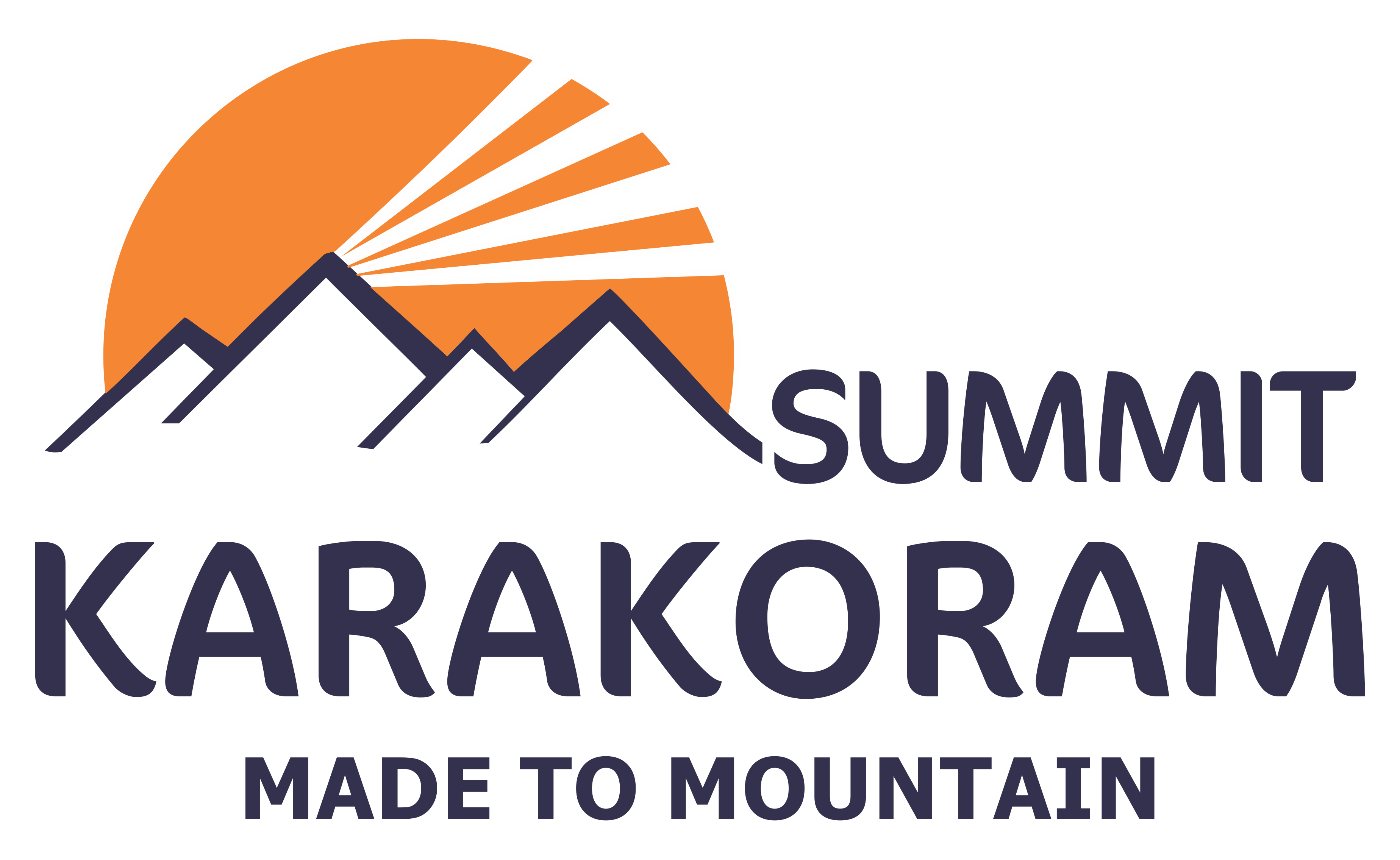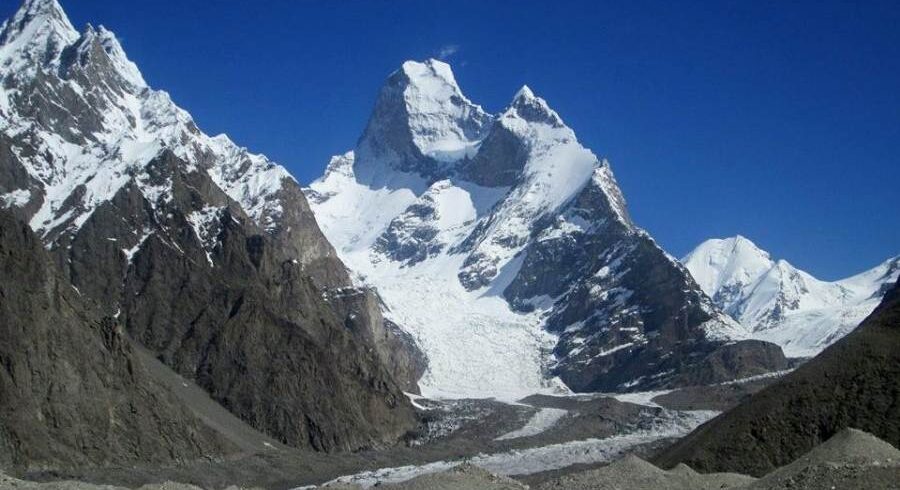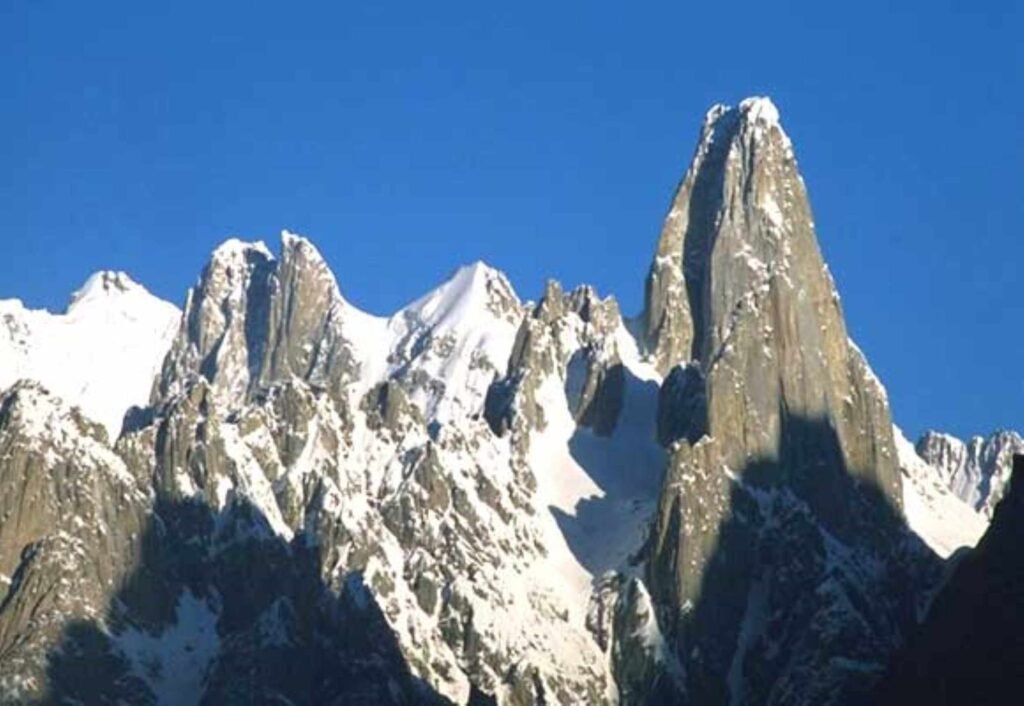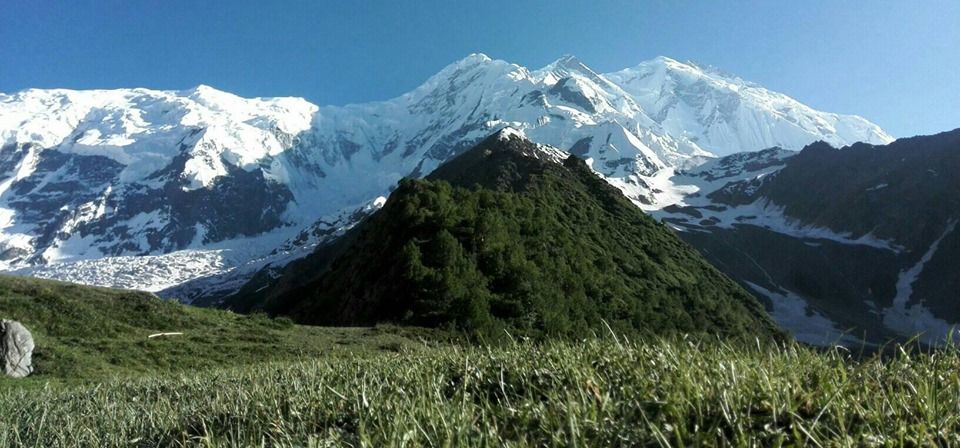Overview
To anyone who has had the opportunity to admire the wonderful photograph taken in 1909 by Vittorio Sella, the Muztagh Tower must have appeared the symbol of inaccessibility. Its 23,800 ft. of vertical walls presented climbing problems of a different order of severity from the ‘eight-thousanders’. Yet while the conquest of the fourteen highest summits of the earth is still not completed, the Muztagh Tower has been conquered. In the month of July 1956, a British expedition and a French expedition saw their efforts crowned with success and eight men reached from two totally different sides of the mountain the summit of this peak which appeared impregnable.But we have a great anxiety: there is no longer any doubt that the British expedition led by John Hartog is aiming for the Muztagh Tower. Including McNaught-Davis, Joe Brown and Dr. Patey, it is one of the best parties of climbers that could be put in the field. The British have been established on the Muztagh Glacier for a fortnight and are attacking by the Chagaran Glacier and the northwest ridge. They are already high on the mountain.
Itinerary
Depart from your own destination, arriving Islamabad the next day and transfer to the hotel for a few hours’ sleep. After an early breakfast we return to the airport for the flight to Skardu, which usually departs mid-morning. Given good weather this is perhaps the most spectacular commercial flight in the world, with magnificent views of Nanga Parbat the ninth highest mountain in the world. The flight however will not operate in poor weather, and you must be prepared for a wait in Islamabad if the flight is cancelled
In case of cancellation of flight (13-14 hrs) drive by coach to Chilas (480 km) on Karakoram Highway. Or Drive to Chilas via the Babusar Pass 4173m. Babusar Pass is a high mountain pass at an elevation of 4.173 m (13,691 ft) above the sea level. The pass is the highest point in the Kaghan Valley, Pakistan. The pass connects the Kaghan Valley via the ThakNala with Chilas on the Karakoram Highway. It’s one of the famous hair pinned roads in the world.
Complete road journey (10-11 hrs) to Skardu (275 km) En-route has good view of Nanga Parbat (8125m) at junction of Indus River and the rapids and fall of Indus River.
Full day for official formalities and final preparation of Expedition at Skardu.
After a free day in Skardu, we travel by Jeep to Askole, the last village between us and K2, This journey takes about 7 hours and is on very rough narrow tracks often blocked / damaged by landslides.
We set off early to avoid the heat of the day. We follow the Braldu river valley through green pastures and after crossing the Biafo River we skirt around the base of the terminal moraines of the Glacier for lunch at Korophon. Beyond here a new path has been cut through the cliffs making the walk to camp straightforward. 7 to 8 hours walking.
We continue up the Braldo River, sometimes close to the raging water, sometimes taking a higher path used by pack animals. If the weather is clear we get our first glimpse of Broad Peak today. Despite the stories in old guide books and journals, much has been done in recent years to remove rubbish and human waste to leave a much cleaner environment with well managed camps.7 to 8 hours walking.
An important resting day follows when the porters will prepare their food for the trek ahead. We will make a side excursion to gain some altitude from where we can get superb views up the Baltoro Glacier.
Today we should get our first distant sight of Broad Peak and the Gasherbrums. A shorter day of walking up the glacier to the campsite which is located on a grassy slope high above the Baltoro and commands one of the most dramatic mountain views in the world, dominated by ‘Nameless Tower’. 6-7hours walking.
We continue gently upwards, passing the Yermanandu glacier which flows down from Masherbrum (7821m), while the Muztagh Tower pierces the sky on the north side. At the head of the glacier Gasherbrum 4 looms large. Tonight we camp on the glacier. 6-7 hours walking.
Transfer to airport for flight to Islamabad if the flight operates otherwise drive (9 hours) to Chilas along the Karakorum Highway. Meals and overnight at hotel.
Free day in Islamabad or drive to Islamabad from Chilas for 12 hours.
Transfer to Islamabad international airport and onward to your own destination.
Costs
The Costs Includes
- All airports pick & Drops on arrival and departures.
- Air condition Transportation for Briefing & De-briefing in Alpine club of Pakistan / Ministry of Tourism.
- Transportation for sightseeing.
- Both Way domestic flights between Islamabad – Skardu.
- Both ways Air condition coaster / mini bus / car between Islamabad – Skardu.
- 4x4 Jeep / Toyotas between Skardu – Askoli both ways.
- Two nights in Islamabad 3*/4* Hotel accommodation with bed & breakfast.
- Two nights in Chilas best standard Hotel accommodation with full board.
- Three nights in Skardu best standard Hotel accommodation with full board.
- Expedition Royalty and Climbing Permit.
- Fully paid Government Liaison officer.
- Documentation.
- Visa facilitation letter.
- Professional guide to transfer expedition to base camp.
- way up 50kg to transfer at base camp for 6000-7000m Expedition.
- Way down from base camp 25kg allow for 6000m-7000m Expedition.
- Necessary base camp staff (base camp manager, Chief, Cook, and Assistance & Waiters.
- Three meals a day and tea – coffee – snacks during the trek and base camp stays.
- Solar panel / generator for light and battery charge at base camp.
- Comfortable foam / mattress while trekking and base camp.
- A north face tent provide as individual member at base camp.
- Hot shower and toilet tents.
- Comfortable chairs and table while trekking and base camp stays.
- Complete camping setup with dinning & kitchen tents while trekking and base camp.
- Imported and local foods during trekking and base camp stay.
- Heating in dinning tent at base camp.
- Medical first aid kit for group and staff.
- Satellite phone for emergency calling at base camp.
- Walkies talkie for base camp communication.
- All camping and bridge crossing fee.
- CKNP west management fee and Gondogoro La rescue fee.
- Assistance for international tickets reconfirmation.
- Farewell dinner will served in Skardu / Islamabad.
- Bamboo Sticks for 6000m -7000m Expedition if require.
The Costs Doesn't Include
- Member international flight tickets.
- Members any Climbing / trekking gears.
- Sleeping bag and all personal expenses such as telephone calls, fax, email charges, liquor or soft drinks,
- Room service, gratuities for personal services, items of a purely personal nature.
- Staff tips, We recommend you to give small bonus for our local staff.
- Mini bars while staying in hotels / travelling.
- Member personal insurance.
- Custom clearing charges (import and export of equipment)
- Oxygen, Mask & regulator sets,
- EPI Gas, Ropes, Ice screws, snow bar, cooking pots beyond base camp.
- RECOMMENDATION:- We recommend our clients to deposit helicopter rescue aviation deposit in advance $5000/- the entire money is refundable if not use. In case any emergency happen on remote mountain range then we fly helicopter on time to save life.
- TRAVEL INSURANCE:- It is a strongly recommend that while booking treks and tours with us that travelers/trekkers must be protected by insurance themselves that covers cancellation, accidents, health, emergency evacuation, and loss of items, or damage to baggage and personal effects.
Maps
Equipment List
- HEAVY BASE LAYER BOTTOMS: Heavy, expedition-weight base layer bottoms designed to be used while climbing in very cold conditions.
- SOFT PANTS: Soft shell pant should be non-insulated, stretchy comfortable, without base layer from top to bottoms recommended. Zip off pants consider and recommended.
- DOWN PANTS: A weatherproof down pants should be fit and good fabric.
- SOFT JACKET: We recommend you to bring a wind – weather resistant Jacket, the layer should be fit from mid layer to base top.
- DOWN jacket: Due to insufficient sweater protection, we recommend you to bring a insulated high quality down jacket, size fit and 1.5 weight suitable.
- RAIN JACKET: A fully waterproof jacket recommend, two to three layer fabric are common, Goretex fabric will be nice in order to protect from heavy raining.
- HARD PANTS: A waterproof shell pant, size should be fit and comfortable from bottoms base layer and soft consider.
- DOWN SUIT: Down suit is common in order to use beyond base camp.
- SYNTHETIC PANTS: A synthetic insulated pant with full-length separating side zips.
- EXPEDITION CLOTHING AS FOLLOWS:
- EXPEDITION MITTENS: Expedition-rated mittens with an insulated removable liner. Please be sure this mitten is the warmest model available by any manufacturer.
- INSULATED SHELL GLOVES: A good leather warm gloves with insulated and removable liners recommended, which shall be useful when the altitude conditions clod.
- LIGHTWEIGHT LINER GLOVES A lightweight synthetic liner Glover requires, size should be comfortable and fit. Colors gray and dark recommended.
- HEAD WEAR AS FOLLOWS:
- HEAD LAMP: A modern outdoor LED headlamp offering 200-300 lumens of output. Freshly installed batteries plus spare batteries. Weather-resistant models are strongly preferred.
- NOSE GUARD: Nose Guard useful while trekking to base camp and beyond.
- SKI GOGGLES: High-quality goggles for sun and wind protection at altitude. The lens should offer visible light transmission (VLT) of no more than 30%. Those with light-sensitive eyes may wish to use a darker lens.
- GLASSES: High-quality glacier glasses offering full coverage around both eyes and across the nose.
- FACE MASK: Best standard models facemask recommended, the sized should be cover your face.
- WOOL/SYNTHETIC SKI HAT: A non-cotton wool or synthetic hat that covers the head and ears comfortably.
- BALACLAVA: One or two good quality lightweight balaclavas require, layer should be in place.
- BUFF: A must-have for all outdoor activities, the UV Buff is a versatile replacement for the bandana and serves a multitude of purposes.
- SUN HAT: Modern style of lightweight hat for shading the head will work well, like base ball sun hats are common.
- CLIMBING HELMET: A lightweight climbing-specific helmet should be fit and comfortable over your bare head.
- HEAD WEAR:
- PEE BOTTLE (1-1.5 LITER) Wide mouth pee bottle use for overnight.
- WATER BOTTLE PARKAS: Bring two fully insulated water bottles parkas with zippered openings. Neoprene ‘cozy’ style constructions do not provide enough insulation and are not recommended.
- PEE FUNNEL (FOR WOMEN) Practice is critical for the use of this item.
- KNIFE: A knife should be light, simple and medium sized recommended.
- WATER BOTTLES: One litter capacity water should be wide mouth made of co-polyester (BPA free plastic). No water bag or bladder systems (they freeze or are hard to fill) and no metal bottles (they have a tendency to freeze).
- THERMOS: A fully vacuum-insulated thermos litter sized is recommended for hydration, comfort, and safety on cold days on the mountain.
- LIPS LOSE: Several tubes of SPF 30+ lips lose. As with sunscreen,
- SUNS CREAM: One to two ounces of SPF 30+ sunscreen. Varieties with zinc-oxide are more protective! One ounce is typically sufficient per week, but several small tubes can offer insurance against lost or exploded tubes. Sunscreen loses SPF rating over time; we strongly recommend brand-new sunscreen.
- TRASH COMPACTOR/CONTRACTOR BAGS: Three heavy plastic garbage bags for use as waterproof pack/stuff sack liners. Trash compactor or contractor bags are made from a heavier plastic and stand up well to prolonged mountain use. Alternatively, a reusable waterproof pack liner can be used provided it completely fills the inside of your pack.
- TOILETRY BAG Include toilet paper (stored in a plastic bag), hand sanitizer, toothbrush, toothpaste, floss, and wet wipes. Choose a quantity appropriate for the length of your trip, and call the Gear Department with any questions about these items.
- CAMERA ACCESSORIES: Small point-and-shoot cameras (including compact SLR’s) are ideal & work well at altitude. Alternatively, many opt to use a smartphone / Iphone camera. Due to weight & care in the mountain environment, large DSLR cameras are discouraged.
- LARGE DUFFEL BAGS Two (2) large duffel bags should be used for transporting all gear to base camp. Soft-sided, water-resistant duffel are required.
- RUNNING SHOES Lightweight, comfortable running or walking shoes are recommended for off-mountain use and pre-and-post trip travel. In some situations, these may also serve as approach shoes.
- HAND AND TOE WARMERS: Bring three sets of each. Please note that toe warmers are different than hand warmers. They are formulated to work in a lower oxygen environment, like the inside of a boot; they also burn out more quickly.
- BOWL: Two-cup capacity pack-able bowl require while climbing beyond the base camp. A good quality bowl and plate recommended.
- WATER MUG: Your mug should retain heat well and be spill resistant. Insulated outdoor-style mug with a removable lid recommended.
- SPOON Durable hard plastic or metal spoon requires while your stays at the mountain climbing. Longer spoon stems can be helpful for eating while wearing gloves.
- INFLATABLE SLEEPING PAD Lengthy sleeping pad recommended, would be better if you can bring valve repair patch kit.
- 55-LITER CLIMBING bag Also 55-60 litters capacity climbing bag require. Simple, light and should be attached point for crampon and Ice axes.
- SMALL bag PACK: At least 30 liters carrying capacity lightweight small bag pack require.
- -20F DOWN SLEEPING BAG A (-20 sleeping bag) require and should be include correct sized compression stuff.
- -40 DOWN SLEEPING BAG: A (-40 Sleeping Bag) should be require as synthetic large light weights designs. A good product recommended.
- TREKKING PANTS Synthetic fabrics trekking pants should be lightweight, 2 pair with zip off models preferred for some.
- BASE LAYERS – TOP & BOTTOM: We recommend you to bring at least 2-3 pair of lightweight base layer, pants, shirts.
- ICE AXE We recommend you to bring a general mountaineering ice axe, too short is preferable, make sure the design should be technical ice climbing.
- CRAMPONS General mountaineering crampons. We recommend modern steel 12-point crampons with anti-balling plates.
- CARABINERs Locking and non locking carabineers pairs need while ascending and descending mountain climbing.
- CLIMBING HARNESS A good quality harness should be fit over your clothing, adjustable leg loops and waist belt should be contain, feature gear loops recommended.
- BELAY DEVICE Modern tube-style belay device. Avoid super-specialized belay devices which cannot accept a wide variety of rope diameters.
- TREKKING POLES Trekking poles while trekking to mountain Range.
- ASCENDER One right or left-handed ascender (pick your dominant hand to choose which style ascender). This item must be in good condition.






